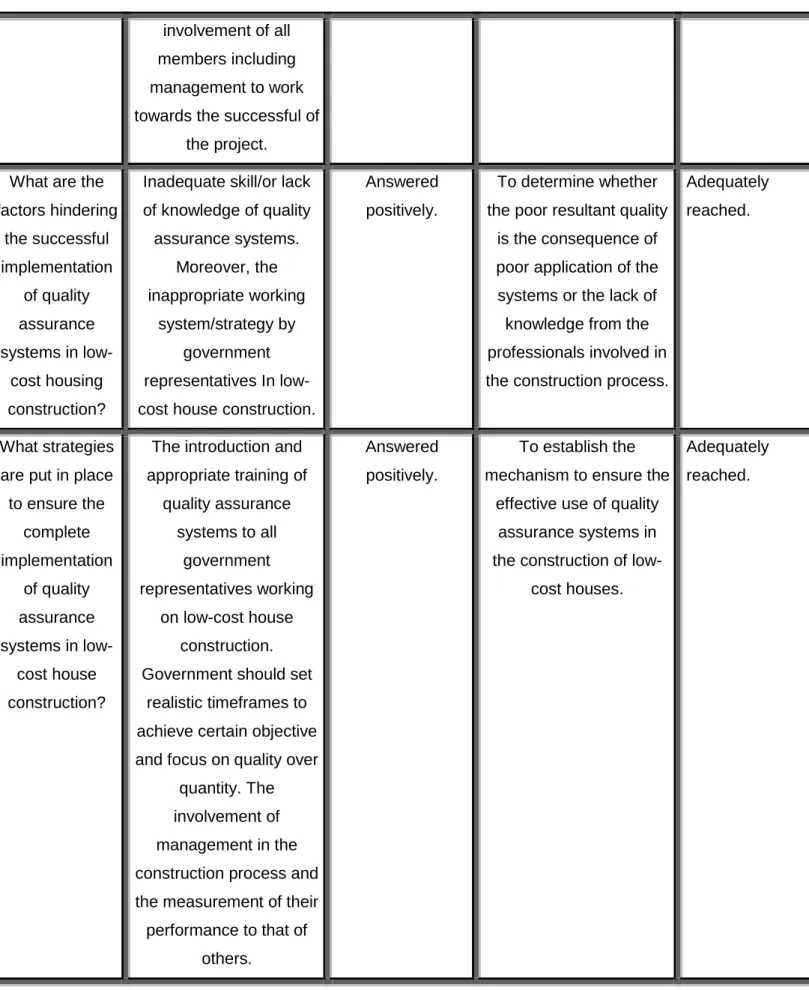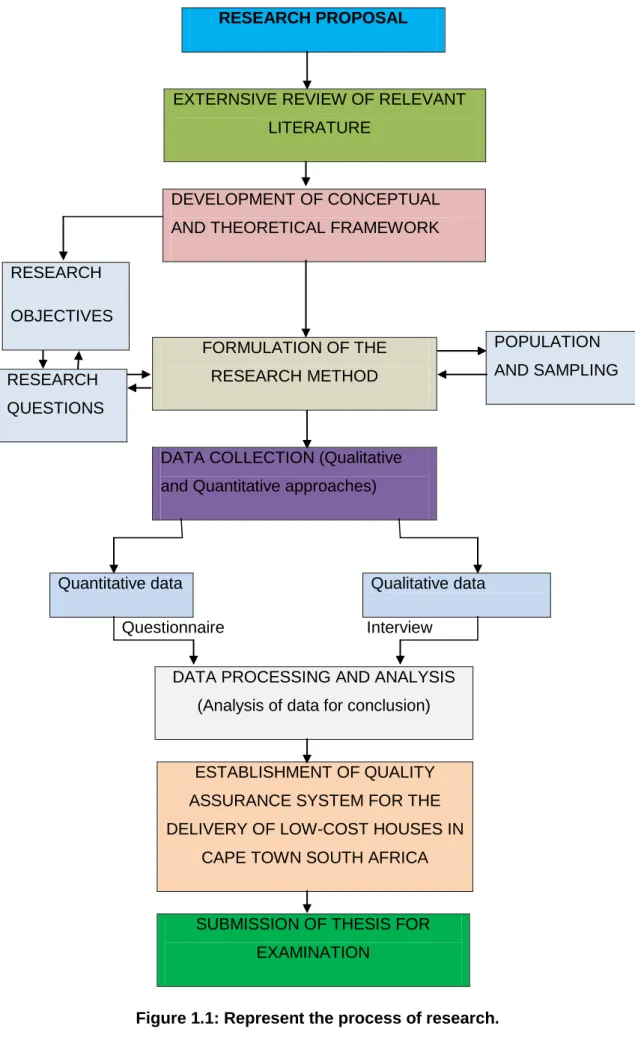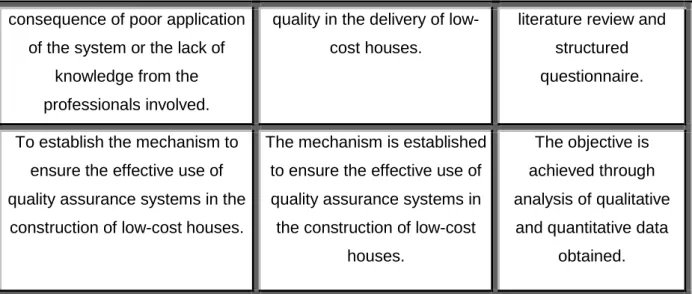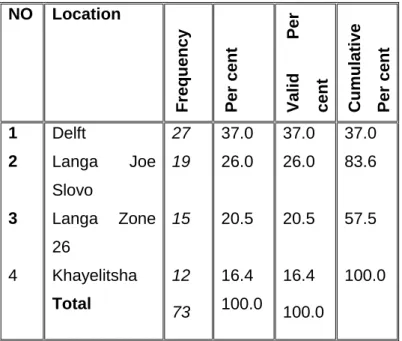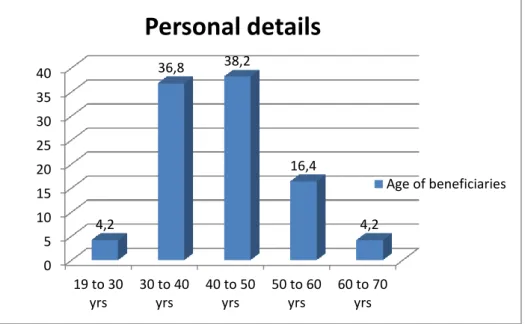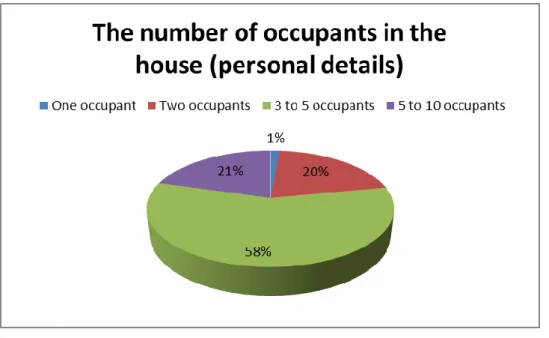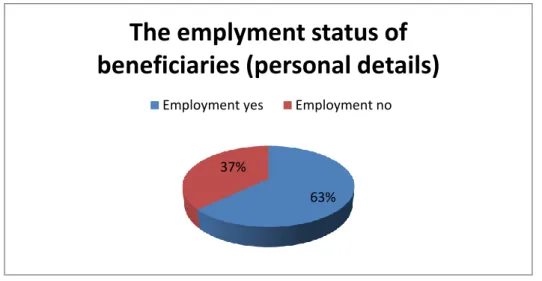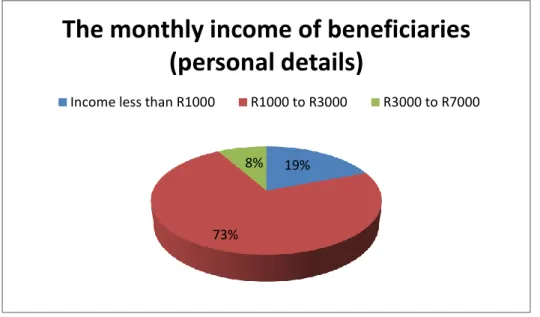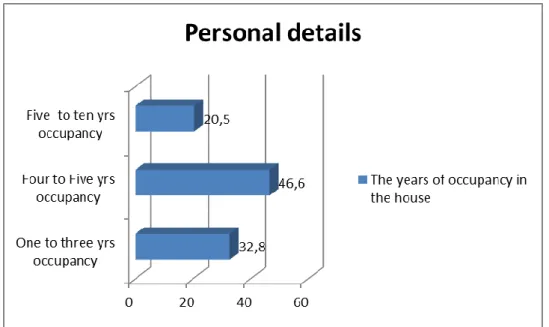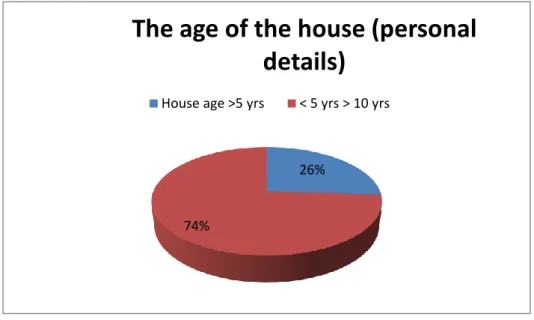The study examines the effectiveness of quality assurance systems in the delivery of low cost housing in Cape Town, South Africa. Finally, the last goal is to establish a mechanism to ensure effective use of quality assurance systems in the construction of low cost houses.
Research Methods Employed
Data Presentation and Analysis
INTRODUCTION 1 Background
- Western Cape Housing Background
- Western Cape Housing Situation (1994-2004)
- The situation in housing (2004-2014)
- Problem statement
- The main research question
- The research sub questions
- Objectives
- Significance of the dissertation
- Methodology
- Research population
- Scope
- Key assumptions
- Limitations of the research
- Program chart
- Conclusion
- Introduction
- Barriers to Quality
- Causes of Poor Quality in Construction of Low Cost Housing
- Impact of Poor Quality
- The similarities of poor resultant quality in Low-Cost Houses (Cape Town) There is a great distinction when it comes to the comparison of the resultant product. This
- Quality Assurance
- Quality Assurance Procedures
- Non-Conformance
- Specifications
- National Building Regulations
- NHBRC and Role of Structural Integrity
- Inspectorate- where does this fit in
- Earned Value
- Benefits of EVMS
- Tools for Better Quality (Quality Assurance Systems) 2.6.1 Strategic Quality Management
- ISO 9000 and ISO 9001
- Information Management
- Quality Control
- Customer Focus And Market Intelligence
- Performance Management Plans
- Process Management
- Training
- Improving Quality
- Definition of Total Quality Management
- Implementing Total Quality Management
- Principle of Total Quality Management The following key principles of TQM are as follows
- The concept of continuous improvement
- Effects of Improved/Better Quality occurrence
- Chapter Summary
- Research philosophies .1 Interpretivism
- Positivism
- Research methodology
- Quantitative Research Methodology
- Qualitative Research Method
- Interviews
- Case Studies
- Questionnaires
- Types of Questionnaires .1 Mailed Questionnaires
- Advantages and Disadvantages of a questionnaire
- Triangulation
- Research approach .1 Deductive approach
- Inductive approach
- Choice of Research Instrument
- Research aim and objective
- Data analysis
- Reliability and validity
- Open-Ended-Questions
- Close-Ended-Questions
- Sample size
- Interviews Survey
- Data Presentation .1 The locations visited
- SECTION A QUESTIONNAIRE SURVEY: Personal Details of Occupants
South Africa is located in the southern part of the African continent and has nine provinces. The quality of housing is expected to be adequate as determined by the Human Settlements Department. However, this is not the case in the Republic of South Africa, but the quality of the houses built for the communities is questionable.
To identify the existence, prevalence and depth of the poor resulting quality in low-cost housing areas. The research is limited to South Africa, specifically to the limitations of the study in the Western Cape. The introduction to the study has been presented, and the extent of the need for quality assurance systems in the construction of affordable housing has been highlighted.
She further emphasized the acceleration of the processes for providing low-cost housing to the beneficiaries. All actors are involved directly or indirectly in the production of low-cost houses and in servicing their performance. This research study combines interpretivist and positivist approaches as reflected in the research method section of the study.
The development of relevant questionnaires for the research title and problem statement has been undertaken.

Personal details
Gender of the beneficiary
Personal data is based on legal requirements for low cost housing in Cape Town South Africa.
Race of the beneficiary
Race of occupants (personal details)
Number of occupants
Employment status of the beneficiary
The emplyment status of beneficiaries (personal details)
This focuses on the residents' ability to maintain their homes through financial strength. This alone is another problem when it comes to the upkeep of the residences as it falls below the required monthly household income requirement.
The monthly income of beneficiaries (personal details)
Duration of occupancy
House age
The age of the house (personal details)
The importance of owing the house
In 2013, the Human Settlement Research Committee revealed the huge housing backlog and predicted an increase by the year 2020 in Cape Town. The pressure from the backlog is putting government departments under pressure to work in abnormal conditions to deliver for communities while the budget remains tight. The pressure to tackle the backlog therefore forced the government to use the iterative design model not far from the design used by the previous government, which somehow accounts for the ongoing quality issues in the resulting product that was constructed.
The location of the houses
House details
- The number of rooms in the house
- The number of windows of the house
- SECTION C: Design Quality
- SECTION D: Workmanship Quality
- SECTION F: Government involvement on low-cost housing
- Priority for houses
It is believed that this affected the well-being of passengers as shown in fig. These similarities include: the size of the house; number of rooms; windows; doors; surrounded by bags and plastered walls and some with vents. As stated above in 5.2.3.5 that the houses were designed similarly, these similarities in Figure 5.15 below included: ceiling, roof beams, roofing, plaster and backwash, electricity, hot water, basic services, clean water and size houses. .
The size of low-cost houses is uniform across the country; From figure 5.15 over 92% of the responses confirmed that the size of the houses was 40m² while 8% of the responses confirmed that the size of the houses was 38m². The design quality of the houses appears to be repetitive design, this is assumed to be another aspect attributed to poor design quality. Table 5.3 below gives brief reasons why residents objected to the quality of workmanship in the construction of low-cost houses in the three areas (Delft, Khayelitsha and Langa).
Home conditions have a direct impact on the healthy lifestyle of those staying at home, either positively or negatively. Figure 5.19 below shows whether there are any of the beneficiary members with illnesses or other disabilities.
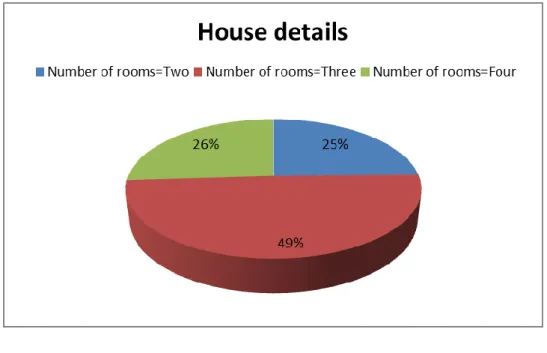
Government involvement on housing
Government response on community demands
The City of Cape Town on the other hand is working towards the target of providing a minimum of 40m² RDP (a subsidized house built between 1994 and before September 2004) or Breaking New Grounds (BNG) house (a house built under BNG policy in the period after September 2004) to waiting list families, low incomes between R0 - R 3 500 per month (with the grant amount provided by the National Housing Department). Government responds to demands=Agree Government responds to demands=Neutral Government responds to demands=Disagree. While 30% of responses disagreed with the government's responsiveness to community members regarding the provision of adequate housing.
7% of respondents either agreed or disagreed (neutral) and 6% strongly disagreed with the government's responsiveness to community members regarding the provision of adequate housing.
Availability of inspectors on site
When it comes to the availability of on-site inspectors during the construction of low-cost houses fig. 22% of the responses either agree or disagree (neutral) that the government sends inspectors on site during the construction of low-cost housing. 66% of responses agree that the government sends inspectors on site during the construction of low-cost housing for inspections to ensure compliance is achieved.
The provision of maintenance plans
When it comes to the provision of maintenance plans by the government to beneficiaries upon official completion of houses, Figure 5.23 above shows that 6% of respondents strongly disagree with the government providing maintenance plans to beneficiaries.
The fight over homelessness
Finally, the inspector suggested that their organizations should step up training on quality assurance systems for all employees working in low cost housing. Finally, the inspector suggested that their organizations should step up training on quality assurance systems for all employees working on low cost housing. In addition, the contractor emphasizes the use of benchmarking mechanisms as a crucial tool for achieving good quality of work and more so for quality assurance in the low cost housing society.
Finally, the contractor also suggested that the introduction and training of low cost housing workers on quality assurance systems would be of great importance. According to the Designer, the words “quality” and “quality assurance” are closely related. However, for the designer, the words "quality assurance" refer to a policy or promise to achieve a quality product.
The designer replied to the question about quality assurance systems that he was familiar with the quality assurance systems. The designer described quality assurance systems as the instrument to realize quality assurance.
Discussion of findings
- Personal details factors
- House details factors
- Design quality factors
- Workmanship quality factors
- Ailments and disabilities factors
- Government involvement factors
- Building inspector factors
- Contractor factors
- Designer factors
The designer thought that the strategy would be to introduce quality assurance systems and develop training for all relevant employees. The inspector from the City of Cape Town confirms the recognition of the quality assurance systems, saying that the city has adopted the international organization for standardization (ISO) 9001 of 2008 and they have introduced ISO in all relevant departments. The inspector from Human Settlements agreed with the inspector from the City of Cape Town on everything except that they are using the standards in Human Settlements as their quality assurance system and the inspector also confirmed that the system is working in delivering low cost houses in Cape Town.
However, the contractor said that the company has not yet adopted a quality assurance system, but in order for the company to improve, they benchmark their performance against competitors. The developer mentioned that projections for low-cost housing are promising in the country, particularly in Cape Town. The only problem mentioned by the designer is the repeated use of the design model in the delivery of low-cost housing across the country.
Like the contractor, the designer touched upon many factors to consider, such as selecting the appropriate procurement system in the early stages of the project and introducing appropriate benchmarking in any organization involved in the provision of affordable housing. However, the City of Cape Town building inspector seemed to understand quality assurance systems and it was assumed that quality assurance was a top priority in their projects.
Summary/Findings
In the previous chapter the questionnaires and structured interviews were carefully analyzed in order to reflect a true result for the hypothesis/or research questions structured in chapter 1. In this chapter the findings, recommendations and conclusions will be presented to conclude this phase of research study.
Chapter 2: reviewed literatures on previous research executed, based on quality, quality assurance and barriers to quality, procurement systems, poor workmanship in the design
On this basis, based on the answers to the questionnaires and structured interviews, it was assessed how quality assurance in affordable housing can be properly implemented and improved in order to eliminate the poor quality in affordable housing.
- Conclusion
- Table showing correlation between research question, objectives and conclusions The correlation between research question, objectives and conclusions will be tabulated in
- References
- Gender (Indicate by making a tick in the box)
- Race (Indicate by making a tick in the box)
- How old is the house? (Indicate by making a tick in the box)
- Indicate the appropriate option regarding beneficiary‟s employment status. Tick with X in the box
- What is the size of the house? (Indicate by making a tick in the box)
- How many rooms does your house consist of? (Indicate by making a tick in the box)
- Indicate the appropriate answer concerning the number of rooms. Tick with X in the box
- Indicate the appropriate answer concerning the space for movement. Tick by X in the box
- How many windows does the house have? (Indicate by making a tick in the box)
- How many air-vents does your house have? (Indicate by making a tick in the box)
- Indicate the appropriate answer concerning the design of the house. Tick by X in the box
- What type of roof trusses is used? (Indicate by making a tick in the box)
- What type of roof covering made of? (Indicate by making a tick in the box)
- Is your house plastered or bagged? (Indicate by making a tick in the box)
- Kindly indicate the appropriate answer concerning the power supply of the house. Tick by X in the box
- Kindly indicate the appropriate answer regarding the hot water supply Tick by X in the box
- Kindly indicate the appropriate answer regarding the basic services. Tick by X in the box
- Please indicate the appropriate answer regarding clean water supply. Tick by X in the box
- In your opinion who should get priority for low-cost housing? (Indicate by making a tick in the box)
- Kindly indicate the appropriate answer regarding privacy. Tick by X in the box
- Kindly indicate the appropriate answer regarding the choice of house design. Tick by X in the box
- Please indicate the appropriate answer concerning the design of the house. Tick by X in the box
- If you were to improve the design of your house, where would you improve the design?
- Indicate the appropriate answer concerning house construction. Tick by X in the box
- Indicate by ticking either a yes or no, which of the problems in the table below relate to your house? Also rate the degree and extent of the problems with a scale from 3,6,9, where 3
- Kindly indicate the appropriate answer regarding the family member(s) with impairment which limits their daily activities or attitude on how they do work. Tick by X in the box
- Indicate by ticking the appropriate impairment in the table below. (Indicate by making a tick in the box)
- Kindly indicate the appropriate answer regarding the quality of workmanship. Tick by X in the box
- Provide a brief a reason for your answer
- Indicate by stating agree, strongly agree, disagree, strongly disagree, neutral.(Indicate by making a tick in the box)
However, the Designer's limited knowledge of quality assurance systems is another factor attributed to the resulting poor quality. The contractor also showed limited knowledge of quality assurance systems and confirms that they have not yet adopted any of the quality assurance systems in the company. However, the Building Inspector from Human Settlements in Cape Town showed limited knowledge of quality assurance systems when interviewed.
To assess the extent to which the existing quality assurance systems used contribute to the current low costs. In addition, the building inspector, contractor and designer emphasizes the use of benchmarking mechanisms as a key tool in achieving good quality workmanship and even more so in quality assurance in a low-cost housing community. The title of the thesis is: "An Analysis of the Effectiveness of Quality Assurance Systems in the Provision of Low-Cost Housing in the Western Cape of South Africa".
This interview also aimed to identify plans and strategies to make the Quality Assurance System effective for the delivery of low-cost houses. What type of quality assurance systems are in practice in the delivery of low-cost housing. What are the factors that hinder the successful implementation of quality assurance systems in low-cost housing.
What strategies are put in place to ensure the full implementation of quality assurance systems in low guest mansions.
